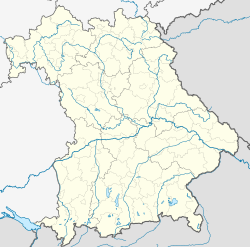Mallersdorf-Pfaffenberg | |
|---|---|
 | |
Location of Mallersdorf-Pfaffenberg within Straubing-Bogen district  | |
| Coordinates: 48°46′N12°14′E / 48.767°N 12.233°E | |
| Country | Germany |
| State | Bavaria |
| Admin. region | Niederbayern |
| District | Straubing-Bogen |
| Subdivisions | 9 Ortsteile |
| Government | |
| • Mayor (2020–26) | Christian Dobmeier [1] (CSU) |
| Area | |
• Total | 72.61 km2 (28.03 sq mi) |
| Elevation | 411 m (1,348 ft) |
| Population (2024-12-31) [2] | |
• Total | 6,722 |
| • Density | 92.58/km2 (239.8/sq mi) |
| Time zone | UTC+01:00 (CET) |
| • Summer (DST) | UTC+02:00 (CEST) |
| Postal codes | 84066 |
| Dialling codes | 08772 |
| Vehicle registration | SR |
| Website | www |
Mallersdorf-Pfaffenberg (Central Bavarian : Mollaschdorf-Pfoffaberg) is a municipality in the district of Straubing-Bogen in Bavaria, Germany and has around 7,000 inhabitants.
Contents
- Coat of arms
- History
- Partnership
- Places of interest
- Cloister of Mallersdorf
- Jewish monument
- Bonifatius-Statue
- Castle Oberellenbach
- Castle Oberhaselbach
- Education
- Public facilities
- External links
- References
Mallersdorf-Pfaffenberg is located in the heart of Bavaria in the south of Germany. The medieval cities of Regensburg and Landshut are within a 30 km radius and even the major cities Munich (München) and Nürnberg are around 100 km away.
The town is well known for the Mallersdorf Abbey, which exists since the 12th century. The Franciscan order of the "Mallersdorfer Schwestern" is busy around the world. Also Pope Benedict XVI enjoyed his vacations here.


